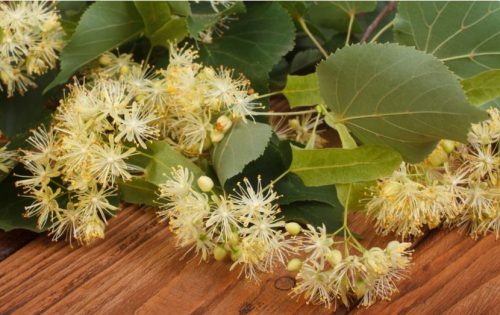A couple of years ago, my husband, my mother and I traveled to England to visit Hubby’s relatives and introduce Mom to her ancestral stomping grounds. While on a day trip through London, we stopped for lunch at a Turkish restaurant on the River Thames. Although it was a pleasant sunny day, the wind had been whipping and I perused the beverages section of the menu for something warm to drink. The lime herbal tea sounded intriguing and I ordered a cup.

When the tea came, I took one whiff and knew instantly that it wasn’t lime. Well, at least not our idea of citrus limes in the U.S. But the light floral scent was unmistakable: this brew was from linden flowers! Somewhere in the recesses of my jet-lagged brain I recalled reading that the British Isles referred to Tilia spp. (also known as linden or basswood) as lime trees. And suddenly it made sense why it was on the menu. Like other aromatic herbs such as chamomile and peppermint, linden tea is a great after-meal drink to aid with digestion. Bonus: linden is a relaxing nervine with cooling and moistening properties, making it an optimal choice for soothing both nerves and a slightly raspy throat after negotiating crowded and windy walkways. Considering the strains of travel from anxiety-producing airports to weather and time changes to different food, linden was a wonderful travel companion to stumble upon!
Historically, linden has been viewed as an herb of the heart. For centuries, Europeans have planted linden trees in town squares and lore has it that young intendeds would sit under their fragrant blossoms in the spring. In addition to being associated with wooing and matters of the heart, linden is used medicinally to treat heart conditions ranging from hypertension (it’s a relaxing nervine) to high blood pressure (it dilates the blood vessels). Because of these properties, Karen Sherwood, my ethnobotany instructor, recommended linden for relief from stubborn headaches.

Learning about linden is like learning a new word. Prior to familiarizing yourself with the word, you would easily skip over or look past it. After learning the word, you’re surprised to see it pop up everywhere. While American species of linden trees are native to the central and eastern states, they remain a popular city planner’s choice and can be found lining city streets and growing in parks all over the U.S.


Although linden honey and teas seem to be common in European markets, I haven’t been very successful finding any at my neighborhood grocery stores. Dried linden can be purchased through reputable suppliers such as Mountain Rose Herbs or Starwest Botanical. However, it’s fun (and free!) to pick your own when the trees are flowering in the spring. Lindens are identified by their serrated, heart-shaped leaves, and in the spring, by their flowers and distinct aroma. The young leaves and flowers are edible and can be added to salads. They can be used dried or fresh to make a tea (just pour near-boiling water over them and steep for 5 minutes), or as an infusion if you want stronger medicinal effects (same as making tea, but let steep for about four hours). You can also add them to honey for a lovely linden-flavored honey. (Better yet, if you ever come across honey actually derived from linden flowers, buy it! It is heavenly.)
Last year I was pleased to find lindens surrounding the parking lot where I volunteered. After my shift, I would wander around the parking lot picking the flowers off the low-hanging branches. I received a few odd stares, but I’ve learned that clothing speaks volumes and if you’re dressed in business casual, people tend to leave you to it – or at least give you the benefit of the doubt instead of reporting you to security. The hardest part about harvesting the leaves and flowers is avoiding the bees. There is always plenty for sharing, though, and happy bees help ensure happy humans.
